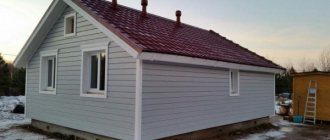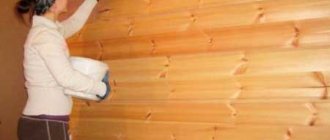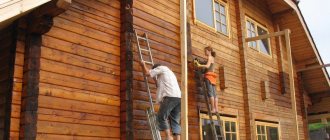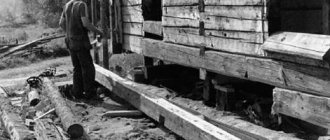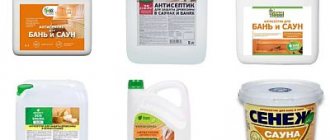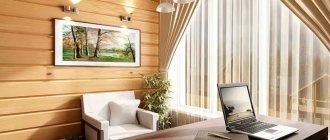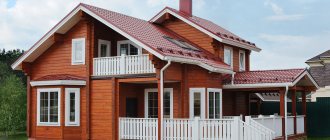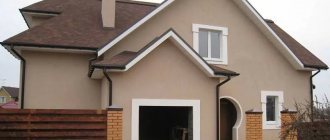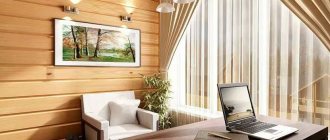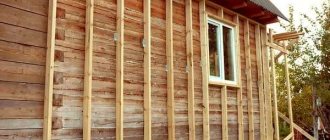Proper care of raised timber trim includes timely painting of this material. It is important to know what paint to choose in order to paint the imitation timber efficiently and reliably. Periodic treatment of wood with the right paint guarantees an impeccable appearance of the interior and exterior walls of the house. Paints and varnishes on wooden panels maintain the safety of products for many years. But in order for such protection of the ball to be correct, you need to know how to paint the imitation timber inside the house, which we will try to figure out now.
Examples of painting false beams Source josri.ru
Types of paints
All paints intended for processing imitation panels are divided into transparent and opaque compositions. The former are indispensable where it is necessary to protect wooden panels from harmful environmental influences, while preserving the original texture of the false beams. For these purposes, varnishes or glazes are purchased that have good protective properties and light decorative effects.
Varnishes, in turn, are divided into:
- Acrylic.
- Water-based.
- Polyurethane.
- Epoxy.
Varnishes can be completely transparent or with a moderate shade; after application, they form a film on the imitation timber finish. Liquid-flowing glazes with protective components penetrate deeply into the wood and leave a beautiful matte shine and the desired shade on its surface.
Painting imitation timber with varnish Source qrepaer64.ru
Opaque coatings include:
- Acrylic paints.
- Alkyd emulsions – oil and enamel.
- Water-dispersion paints.
If you apply opaque paint to the imitation timber, the real wood pattern will be completely painted over with pigments.
Opaque paint in the design of imitation timber Source antiseptik.com.ua
Paints for interior decoration
The primary function of painting imitation timber indoors is for decorative purposes. Interior wall decoration usually does not have any special requirements for protection. The exception is rooms with high humidity - sauna, bathhouse, bathtub, kitchen. It is advisable to treat such rooms with stronger paints. In other cases, the emphasis is on the decorative properties of the compositions, for which opaque coatings are selected that create the necessary textural effect.
The range of painting compositions for interior walls consists of the following items:
- Oil paint.
- Enamels.
- Acrylic paint.
- Alkyd paint – for baths, saunas and swimming pools.
Painting imitation timber inside the house Source suporteimoveis.com
Before painting imitation timber inside the house, you must follow the basic rule: when buying paint for a living space, you need to rely on the safety of the coating. When selecting materials, you should pay attention to a trusted manufacturer. Low-quality paint is toxic and releases harmful substances into the air during the entire period of operation. Knowing how to properly coat imitation timber inside a house, a person will protect himself and his loved ones from the negative consequences of painting. The best paint option for interior decoration is water-based compositions.
See also: Catalog of companies that specialize in finishing materials.
Choosing a paint material for exterior finishing
External cladding boards can be damaged by sudden temperature changes, precipitation, and scorching sun. The main criterion for painting imitation timber on the outside of a house is the protective properties of the coating. Changing the appearance of the panel comes second here.
Assortment of facade paints for timber:
- Professional – applied using special technology.
- Alkyd.
- Acrylic.
- Silicone.
Painting imitation timber from the outside Source lt.decoratex.biz
The finishing coating protects the panel as much as possible from destruction. For the best effect, painting with a decorative layer is carried out in three stages. How exactly to paint imitation timber on the outside depends on many factors - each paint coating differs in price, durability, and application technology. For coating imitation timber, the acrylic variety of compositions has proven itself well. Facade water-based paint, bound with silicone resins, has decent characteristics: resistance to moisture, cracks, and abrasion. However, silicone paint is not as common in household repairs as other types of coatings due to its inflated cost. Alkyd enamels are a good choice in terms of price-quality ratio.
Impregnations
Wood is a capricious material. It is susceptible to attacks by pests, microorganisms, and fungi. It is also a flammable material. To protect the finish from threatening factors, various protective impregnations are used:
- antiseptics
-
effective against fungi, bugs, rotting; - flame retardants
-
prevent ignition or rapid spread of fire; - biopyrenes
are
combined preparations that reduce the fire hazard of a material and also protect against insects, mold, and mildew.
Many of them perform not only a preventive function, but also have coloring properties. After such a product, you can use a topcoat.
Attention!
Manufacturers often supply the market with finishing timber that has been treated with similar substances at the factory. This information is usually indicated on the packaging.
Prices for glaze impregnation for wood
Glaze impregnation for wood
Video - Wood treatment with impregnations
Service life of various paints
One of the quality criteria for paint applied to imitation timber is the service life of the coating. The time during which the paint performs its functions is different for each type of paintwork material. The performance capabilities of paints depend to some extent on the preparation of the surface to be painted and the coating technology. In many ways, the durability of paints determines the degree of aggressiveness of the environment.
A variety of paints to imitate timber Source gid-str.ru
If during the production of paints all GOST requirements were met, the coating acquires the properties indicated in the description. Accordingly, the correct choice of coating guarantees good results for many years. Performance characteristics of paints and varnishes for wooden bases:
- Oil paint based on natural drying oil – no more than 3 years.
- Enamel based on alkyd resin - 10 years.
- Acrylic paint with polyacrylate binder – at least 8 years.
- Water-dispersion coating with organic solvent – 20 years.
- Water-dispersed mineral based – 10 years.
- Silicone based on silicone resins – 20 years.
If exterior panels are treated with a clear coat, you should be prepared to repaint in 2 to 3 years.
The main activity of our company is the sale of high-quality wooden building materials. We set prices from the manufacturer. The assortment includes products made from pine, spruce, larch, linden and other wood. The material is always available in warehouses.
It is profitable to cooperate with us because we:
High-quality materials, good pricing policy, prompt delivery - this is it.
Preparation of paint
The coatings market today is crowded with different types of coatings. The supplier sets fairly high prices for higher quality products. It is important to guess correctly with the amount of paint, so as not to further undermine your budget with unnecessary waste. The interior and exterior finishes of imitation timber are painted in several stages; this must be taken into account when preparing paint and varnish materials. A smooth wooden surface, unlike a rough one, absorbs much less paint.
Paints for false beams, applied in a dense layer Source provagonky.ru
By multiplying the total area of the walls by the number of layers of paint, you can find out how much paint and varnish material you will need to purchase for exterior or interior painting. Paint consumption may vary if the composition is diluted with solvents.
How to properly paint a surface outside
The imitation timber is sanded before painting on the outside of the house. If the surface is of poor quality, then use sandpaper with a grain of 80, and then 120-150. If the product is of normal grade, you can initially process it with an eccentric tool with a grain size of 120-150.
After sanding, the surface is primed with a roller or brush. It is best to paint the back of the board as well: this will save you from mold and uneven moisture release in the future.
Next, apply the first layer of paint or varnish. It is important to do this with a spray gun or brush, very carefully. It is advisable to forget about the roller - painting with it will be terrible.
When the first layer has dried, we do intermediate sanding to remove the lint. To do this, use a 150-grit machine to shake off dust and small fluff, making the surface smooth (you can check it with your hand). Then we apply the final paint coating.
Preparing imitation timber for painting
Regardless of the type of paintwork, the surface of the cladding board should be properly prepared before starting painting work.
As a rule, ready-made imitation panels for timber are already polished and do not require additional mechanical processing. Except in cases where you need to remove the old flaking layer of paint, dirt and dust. A clean, treated surface improves the adhesion of paints and varnishes to wood. Preparing the finish also involves protecting the wood from fungal infections.
Additional mechanical processing can give the wood a more pronounced naturalness. To do this, it is convenient to use a special brush with stiff bristles, which leaves small indentations in the wood. This method of preliminary preparation is appropriate if transparent paint is intended to be applied.
Antiseptic preparations are suitable for the processes of rotting and deformation of wooden panels under the timber. Most paints apply well to imitation timber, so priming the wooden surface is not necessary. Painting work begins after the compositions have completely dried on the surface of the base material.
Do I need an antiseptic?
There is no doubt that wooden cladding with imitation timber used outdoors needs protection from biological damage. On the façade there is always an increased danger of the material becoming wet, and this is the first step to the appearance of mold, rot, fungi, algae, mosses... After all, water is a breeding ground for pests of all types. And wood-boring insects on the street have a greater chance of settling into our false wall.
It should be noted that similar protection will also be required in the case of wall cladding in rooms with high humidity.
The question remains: is it worth impregnating the walls with an antiseptic after installing the imitation timber, or is it better to treat the material before fixing it in place, when it is possible to protect:
- The front surface
- Castle elements,
- The back surface
- The ends (in fact, this is the most vulnerable part),
- Wooden frame made from edged timber.
In the provisions of the currently valid GOST 8242-88, we are told that not all profiled parts made of solid wood are subject to mandatory antiseptic treatment. Bioprotection requires treating the back surface of only the window sill board and only the floor board. And where protective and decorative treatment is present, biosecurity is not required according to this standard.
In principle, you can limit yourself to following just such instructions, especially when it comes to cladding walls inside a building. However, it is still better to treat the façade material with some kind of non-washable compound. For example, you can use antiseptic "Nortex®"-Lux. And if suddenly wooden surfaces already have some traces of infection, then it makes sense to treat them with a “treating” agent, for example, “Nortex®”-Doctor.
Painting interior walls to look like timber
The interior atmosphere of a room largely depends on comfort and coziness. You can achieve the desired result using an original timber finish. Lumber will retain its decorative properties for a long time if it is periodically treated with special paint to imitate timber inside any room.
Practical tips:
- When mixing the paint composition, you must follow the proportions specified by the paint manufacturer. Information about this is contained on the product packaging.
- To work you will need a painting tool. An ordinary brush is resistant to chemicals and can withstand stress.
- To avoid smudges and unevenness of the layer, you need to work slowly and carefully, immersing the brush in the composition up to half the bristles. A small amount of paint on the surface is distributed as thinly as possible.
- For large volumes, it is convenient to apply the composition with a roller or spray gun.
- Re-painting is possible after the first layer of coating has completely dried.
The process of painting internal walls made of false timber Source es.decoratex.biz
Modern paints for interior work are non-toxic and do not have a strong odor. It is safe to work with such compounds even with prolonged contact.
Required materials and tools
Before you start painting your house, prepare all the tools you may need in advance. This will allow you not to be distracted while searching for the right item.
- Protective work clothing, rubber gloves, safety glasses;
- brush, roller, spray bottle;
- container for liquids (primers, drying oils, impregnations, paints and varnishes);
- sandpaper or angle grinder (angle grinder) with a replaceable disc for grinding;
- consumables (antiseptic, primer, paint and varnish);
- stepladder, scaffolding or sawhorse;
- paper (masking) tape.
If you plan to paint your house with a spray gun, you will need electricity to connect it. Also, electric current will be needed to turn on the angle grinder.
Painting the facade to look like timber
External painting of imitation finishing technology is not much different from internal painting. The use of professional compounds requires specific skills and equipment, so it is rational to entrust such work to specialists. Before painting, wooden panels under the timber must be prepared as described above. After opening, the coloring composition is thoroughly mixed. For a spray gun, the paint is pre-diluted with a solvent.
Features of applying external paint:
- If necessary, use protective equipment.
- To carry out work, you need to choose dry and windless weather.
The process of painting imitation timber from the outside Source josri.ru
Thanks to the bright and rich shades, the exterior decoration of the house always looks fashionable and stylish. The neutral natural color of the facade under the timber is combined with any shade of the roof; the bold colors of the houses need to be selected more carefully to match the shade of the roof.
Colored or clear coating
You need to choose transparent or colored paint, taking into account personal preferences and the design of the room. The compositions are practically no different, except for the pigment.
If you want to preserve the unique pattern of wood and its natural color, then it is better to opt for transparent impregnations.
If you need to change the tone of the surface to a darker or lighter shade, you should use glazes - this is an almost colorless material that is used to create an antique look of wood.
To completely change the color of the surface, paints are used - there are different colors, from natural shades to unnaturally bright ones.
Wood bleaches
Often, owners of a house finished with imitation timber are faced with a problem such as darkening of the surface. Bleach helps restore the original color of wood partially or completely. These products have a dual effect of brightening and minimizing the development of fungus. Bleach is based on chlorine and oxygen-containing agent.
When working with chlorine-based bleach, you must be careful, since the main active ingredient is a rather aggressive alkali.
After treatment with bleaches, salt deposits remain. They must be washed off from the surface of the timber. To wash wood, use an aqueous solution of citric or acetic acid in a concentration 4%
, which neutralize the effect of salts.
If this requirement is ignored, salt deposits begin to accumulate moisture, which leads to deterioration of the condition of the false beam. Another negative effect of improper use of bleach is damage to cellulose and lignin.
The surface of the wood loosens, which causes adhesion to paints and other finishing materials to deteriorate.
Attention!
When working with chlorine preparations, it is important to adhere to safety regulations. Otherwise, chlorine vapor poisoning is likely.
Ready-made wood bleaches available for sale:
- Neomid 500 (chlorine-containing);
- Senezh Effo
(based on a transfer agent,
without chlorine
); - Tikkurila Homeenpoisto
(active ingredient -
hypochlorite
), the drug is used even for painted surfaces; - Sagus et al.
When working with bleaches, observe the following safety rules:
- do not mix products, especially if they are based on different active ingredients;
- in case of severe damage to the surface, use higher concentrations of agents;
- Be sure to carefully read the instructions and strictly follow its requirements.
Useful video
How to paint the outside of a house, technology on video:
The imitation timber arrived in time for the May holidays and was stored inside the house. We also purchased 5 liters of Teknol 1881 primer and 20 liters of Nordica Eco 3330 paint.
I decided to prime and paint the first layer of paint on the ground. To a certain extent, this is more convenient, and besides, you are not dependent on the vagaries of nature.
Thanks to the lack of partitions inside, the entire house turned into a huge paint booth. An unpainted imitation was stored against one wall; in the center there were trestles on which boards were laid for painting and then transferred to the other wall, where they were stored for final drying.
8-10 boards were painted in one “batch”.
Primer 1881 was tinted to match the paint color to make it easier to understand where the surface was already primed and where it was not yet.
The 1881 primer itself, according to Teknos instructions, was diluted with water in a 1:1 ratio. The sellers recommended not to dilute, for better coating quality, but in this case the soil would have to dry for a very long time and at a good summer air temperature of at least +20 degrees. And it's May outside.
After the primer had dried, the imitation timber was painted in the same way with Nordca Eco 3330 paint.
By the way, painting with paint is much easier than with primer. The entire imitation was painted in just 1.5 days, including smoke breaks.
The main painter was my wife, and I joined her only periodically.
In total, priming and painting took about 3.5 days of leisurely work by 1 person.
